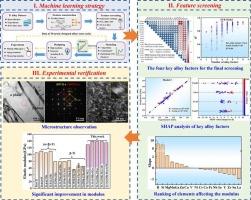Selection of key alloying elements for improving the elastic modulus of titanium alloys based on feature screening methods
IF 7.9
2区 材料科学
Q1 MATERIALS SCIENCE, MULTIDISCIPLINARY
引用次数: 0
Abstract
Under the background of modern industrial lightweighting and high performance, the low elastic modulus of titanium alloys has become a key issue restricting their structural efficiency and load-bearing capacity. This study conducted feature screening on a small sample dataset, identifying the mean of atomic energy of the ground state (Fm1), the mean of a-lattice constant (Fm29), the mean of nuclear charge number (Fm40), and the variance of melting enthalpy (Fv43) as the four key features affecting the elastic modulus. The prediction accuracy R2 of the best model reached 0.96, and a mathematical expression linking the modulus to these four key alloy factors was established using symbolic regression algorithms, achieving a direct correlation between input and target performance. Experimental verification revealed that, in addition to B and Si enhancing the modulus of titanium alloys, the element Ga can also significantly improve the modulus of titanium alloys. Alloys with elastic modulus exceeding 135 GPa were successfully prepared, achieving an increase of over 25 % in elastic modulus compared to TC4 alloy. Further research indicates that the high modulus properties of titanium alloys are primarily attributed to the precipitation of high-modulus second phases α2, TiB, and Ti5Si3 in the microstructure.

基于特征筛选法提高钛合金弹性模量的关键合金元素选择
在现代工业轻量化和高性能的背景下,钛合金弹性模量低已成为制约其结构效率和承载能力的关键问题。本研究对小样本数据集进行了特征筛选,确定了基态原子能平均值(Fm1)、a晶格常数平均值(Fm29)、核电荷数平均值(Fm40)和熔化焓方差(Fv43)为影响弹性模量的四个关键特征。最佳模型的预测精度R2达到0.96,并利用符号回归算法建立了模数与这四个关键合金因素之间的数学表达式,实现了输入与目标性能之间的直接关联。实验验证表明,除了B和Si元素能提高钛合金的模量外,Ga元素也能显著提高钛合金的模量。成功制备了弹性模量超过135 GPa的合金,与TC4合金相比,弹性模量提高25%以上。进一步研究表明,钛合金高模量的主要原因是组织中析出高模量第二相α2、TiB和Ti5Si3。
本文章由计算机程序翻译,如有差异,请以英文原文为准。
求助全文
约1分钟内获得全文
求助全文
来源期刊

Materials & Design
Engineering-Mechanical Engineering
CiteScore
14.30
自引率
7.10%
发文量
1028
审稿时长
85 days
期刊介绍:
Materials and Design is a multi-disciplinary journal that publishes original research reports, review articles, and express communications. The journal focuses on studying the structure and properties of inorganic and organic materials, advancements in synthesis, processing, characterization, and testing, the design of materials and engineering systems, and their applications in technology. It aims to bring together various aspects of materials science, engineering, physics, and chemistry.
The journal explores themes ranging from materials to design and aims to reveal the connections between natural and artificial materials, as well as experiment and modeling. Manuscripts submitted to Materials and Design should contain elements of discovery and surprise, as they often contribute new insights into the architecture and function of matter.
 求助内容:
求助内容: 应助结果提醒方式:
应助结果提醒方式:


